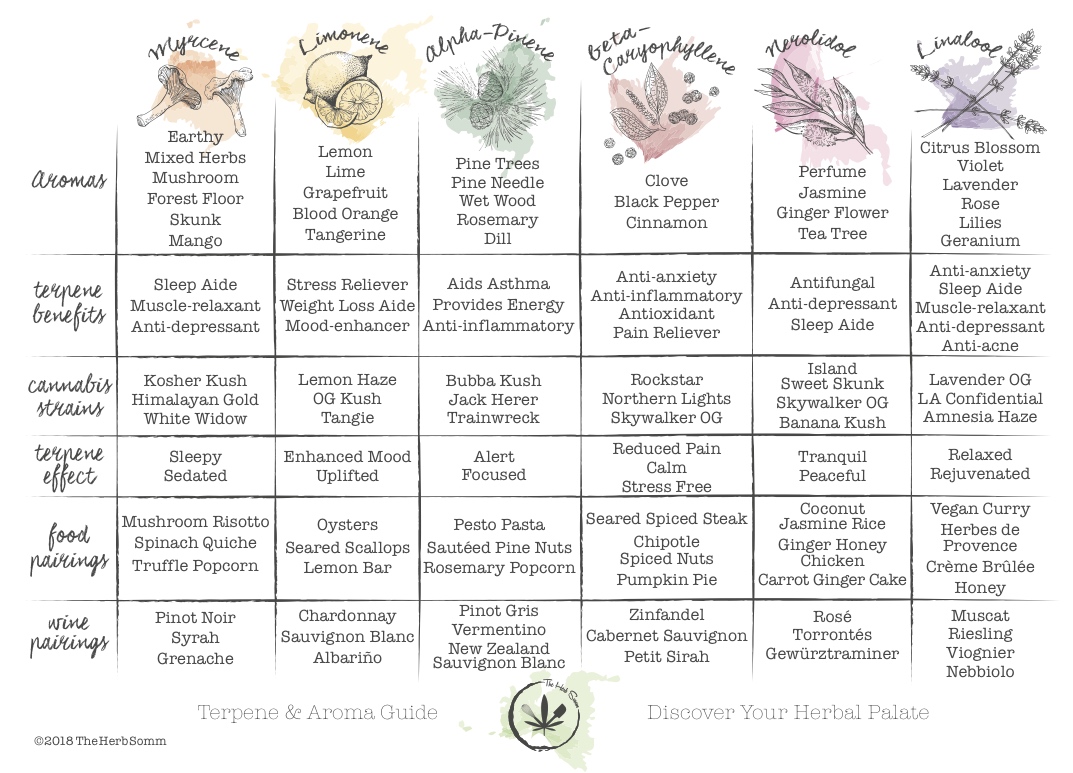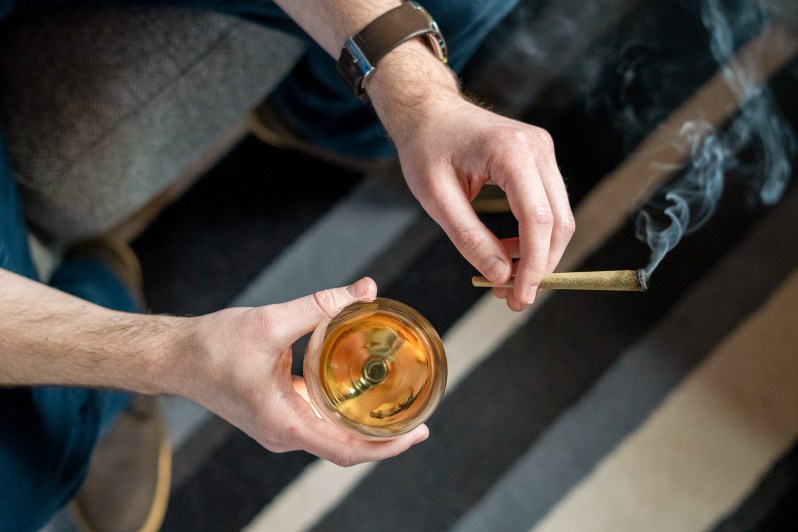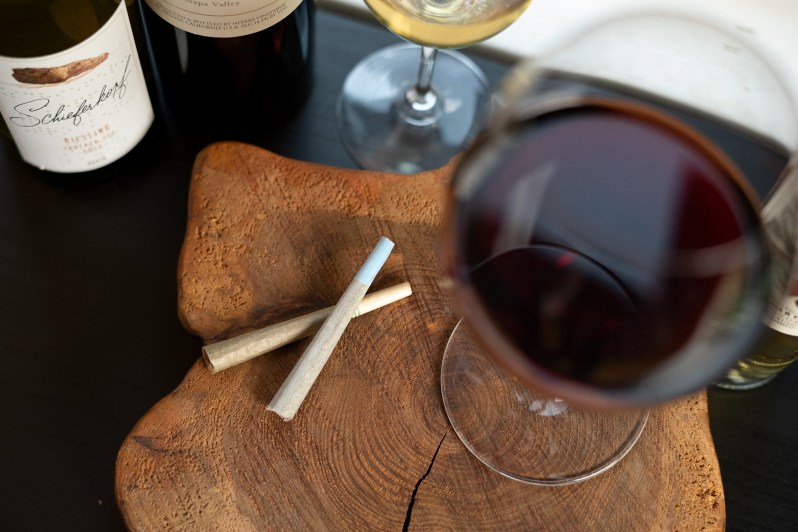In light of the upcoming weed-centric holiday, 4/20, and the fact that 11 states allow the sale of cannabis to anyone over the age of 21 and 33 states offer legal routes to obtaining medical marijuana, there is — at least for some — even more reason to celebrate. Depending on where you are — California or Colorado, say — the marijuana industry accounts for an ever-growing segment of their economies, with boutiques, cafes, restaurants, and other businesses with a focus on ganja popping up everywhere.
Since marijuana can now be enjoyed out in the open (in certain states, at least), figuring out how to combine cannabis with different foods and beverages is an exciting challenge for hospitality professionals … and for ambitious home entertainers, too. If your idea of a great house party involves pairing your favorite strains of weed with your favorite bottles of vino, then we’ve got just the guide for you. We spoke with pro chefs, marijuana producers, and sommeliers to find out which wines they like to sip alongside a joint, a packed pipe, or a vape, and here’s the very useful information they shared.
Approach wine-and-weed pairings in a similar way to food-and-wine pairings.
“When pairing wines or any other beverage with cannabis, it is important to first identify the flavor profiles and the aromas of the beverage you are [drinking] with your cannabis. Just like most other things that you consume, different cannabis strains each have their own unique flavor profiles and aromas, which will help guide you to the perfect wine pairing,” explains chef Brandin LaShea, host of cannabis cooking show Pot Pie on Pluto TV. Just as you might pair a chicken in a cream sauce with a white wine with gentle acidity to work as a counterpoint to the sauce’s richness, drinking a wine with flavors that positively contrast with the taste and scent of the cannabis makes for an ideal experience.
Pay close attention to terpenes.
When we asked certified wine specialist and “herb sommelier” Jamie Evans of The Herb Somm to offer advice on pairing wine with cannabis, she provided a clear and simple answer: “If you’re looking to pair cannabis and wine, the first thing I recommend is to get to know your terpene profiles. If you’re new to terpenes, they are one of the most crucial compounds that differentiate plants, herbs, flowers, and spices. They’re also the organic compounds that give cannabis all of the wonderful aromas and flavors that you perceive when you’re smelling through your favorite strains, [and they] offer many other therapeutic benefits.”

Weed newbies (and/or weed-wine pairing newbies) may wonder how to identify these terpenes and link the versions present in cannabis to those in wine. Luckily, Evans is here to talk you through it. “Remember, the goal when creating a pairing is for all of the components to enhance each other. You might even be surprised if the combination creates an entirely new flavor not yet experienced in the food, wine, or cannabis alone. This is what I call ‘discovering your herbal palate.’ Much like evaluating wine, you can also use sensory evaluation techniques to prep your nose and palate for interpreting cannabis. For example, the next time you purchase some flower, put it in a wine glass and begin to smell the different aroma layers that jump out of the glass. Try to evaluate the cannabis like you would a wine. Inhale several times briefly, making a mental imprint of what you’re perceiving. Compare and contrast against other strains. What are the differences? The more you practice, the easier it will be to identify your favorite terpenes, which will lead to harmonious cannabis and wine pairings. And if you didn’t know already, wine has terpenes, too, which makes the pairing concept viable,” she explains.
Allow the environment in which you’ll enjoy your wine and weed to inform your pairings.
Most strains of marijuana fall into one of three categories: indica, sativa, or hybrid. Indica-heavy strains provide a relaxing, full-body high, sativa strains boost your energy and give you more of a “mental high,” and hybrid strains combine characteristics of both indica and sativa. Cannabis expert Ian Kelly of NuLeaf Naturals points out that the strain you choose and the wines you select to pair with it should depend on the vibe you’re seeking for your particular gathering. “Your environment can play a role in deciding what to pair. If you just want to relax at home and get a good night’s sleep, then a heavy red with a heavy indica should do the trick. At a dinner party, it’s best to avoid that sleepy combo and opt for a hybrid or sativa instead,” Kelly tells us.
The wines you select to pair with it should depend on the vibe you’re seeking for your particular gathering.
If you’re cooking with marijuana, use the sous-vide method to make flavorful infused dishes that pair well with wine.
Cooking with cannabis (or CBD, a compound found in these plants that’s legal in many states where full-fledged marijuana isn’t yet) is gaining traction among professional gourmands, but if you want to try it out in your own kitchen, it helps to have a distinct game plan and to know which techniques best serve both the flavor of the food and the effects of the added “herb.” According to Evans, the sous-vide method fulfills both criteria, and then some. “If you’re considering cooking with cannabis and would like to pair wines with your infused meal, be aware that terpenes can burn off quickly if you overheat the cannabis ingredient that you’re working with. To best preserve terpene profiles, I highly recommend using the sous vide method for infusion,” Evans says.
When it comes to pairing marijuana with tannic reds or high-ABV wines, proceed with caution.
While wine and weed generally make for a harmonious combination, qualities present in certain wine varietals and certain marijuana strains can prove complicated and, ultimately, undesirable. Our surveyed experts advise paying close attention to the tannins (astringent compounds present in wine grape skins) and the alcohol content of your wines, as both may potentially complicate the dynamics of the pairing.
“The last thing you want in a wine pairing with weed is tannins. If your wine is heavy on tannins, it will dry out your mouth, compounding the cotton-mouth that can occur from weed. These wines almost always need to be paired with food, and will not feel refreshing or pleasant when paired with weed,” cautions wine enthusiast and co-founder Joe Welch of In Good Taste. If you’re especially sensitive to tannins, Welch cautions against “Cabernet Sauvignon, Zinfandel, red blends, Merlot, and most heavier Italian reds like Barolo or Nebbiolo.”

Karli Warner of California-based cannabis company Garden Society advises against pairing weed with wines that involve a high ABV, explaining that “I avoid higher ABV wines with cannabis as they are multipliers of each other. I enjoy the social aspect of a smoke and a glass of wine, and living in Wine Country, it’s part of life, but I do think [that] just a small glass is perfect to wet my whistle on a fun evening with family!”
The first time you try pairing cannabis with wine, “take it slow.”
Any blend of alcohol and cannabis can absolutely prove potent, especially to those who haven’t experienced this combination before. For that reason, cannabis farmer and owner Johnny Casali of Huckleberry Hill Farms in Humboldt County, CA recommends that newcomers “take it slow.” “Personally, we tend to stay away from heavier wines when we know that cannabis has heavier medicinal effects. Both heavy effects tend to be “downers” for us and make us more sleepy than desired. We want to caution anyone pairing cannabis and alcohol for the first time to take it slow because the effects are limitless and may end up resulting in a bad time!” Casali suggests.
Wine and Weed Pairings
White wines with sativa-dominant strains

According to LaShea, “white wines like Pinot Grigio, Sauvignon Blanc, Chardonnay, and Pinot Blanc will sometimes have either dry or sweet characteristics and a fruity crispness that comes from citrus fruits or tropical fruits. These wines pair best with lighter citrusy sativas and hybrid dominant strains like Jack Herer, Maui Waui, Super Silver Haze, Pineapple Express, Mango Kush, and Lemon Kush, because all carry the same limonene terpenes (natural lemon scent).”
Bold red wines with indica-dominant strains
If you’re more in the mood for a mellow indica strain, LaShea recommends “bold reds like Cabernet Sauvignon, Malbec, and Petite Sirah, [which] are all full-bodied wines that have a variety of dark fruit flavors (blackberry, black currant, plum) and sometimes pepper, cloves, or cinnamon. These wines pair best with bold, heavier indica-dominant strains like Skywalker OG, Blackberry Kush, Grand Daddy Purp, and Northern lights, [which] carry the same dark fruit and earthy aromas.”
Rosés are very flexible
Rosé manages to function as a jack-of-all-trades wine, at least where marijuana pairings are concerned. Evans tells us that “I consider rosé one of the most versatile wines [for pairings]. Rosé wines typically have higher acidity and more neutral flavors, [so] they pair exceptionally well with a wide selection of cannabis strains, particularly those that have pronounced limonene (citrus) or linalool (floral) terpene profiles.”
Frizzantes and skin-contact whites taste especially refreshing alongside cannabis
When in doubt about a wine-weed pairing, go for a frizzante (a slightly-sparkling wine) or a skin-contact white wine (also known as an orange wine). Beverage director Jordan Veran of Sauced in Brooklyn tells us that “ I personally love a nice frizzante or skin-contact white while I smoke. Something fresh that goes down easily to help with the cotton mouth!”
Expert Recommendations
If you’re looking for a more specific guide to strains and wines that make a solid team, our experts provided a few particular favorites:
Grand Daddy Purp and Cabernet Sauvignon

When it comes to a rich, indica-heavy strain like Grand Daddy Purp, LaShea likes to match it with a robust California Cabernet Sauvignon. “My favorite wine-cannabis pairing is Cabernet Sauvignon and Grand Daddy Purp, or any other heavy fruity indica strain. Being from California, we are truly spoiled by having some of the best vineyards outside of Europe and some of the best cannabis in the world! California’s most widely planted grape is Cabernet Sauvignon, which is known as the “king of the red wine grapes” and is the dominant grape found in some of California’s best wines. Cabernet Sauvignon grown in California tends to be pretty fruit-forward, but mellow at the same time, with rich dark fruit notes of blackberry or blueberry and some earthy notes, like cedar and mocha. This wine pairs best with heavier indica strains Grand Daddy Purp,” LaShea tells us.
Crème Brûlée and Riesling
Creme Brûlée is a sometimes tough-to-locate indica strain, and in-house edibles expert Matt Kulczycki of CannaCraft appreciates the way that it pairs with the German white wine varietal Riesling. Kulczycki says that “my [culinary] specialty is pastry, so my absolute favorite dessert pairing is Crème Brûlée — [the] Indica cultivar, not the custard — with a Napa Riesling and warm apple pie.”
Sour Tangie and Chardonnay
A sativa-dominant hybrid strain, Sour Tangie works well alongside a Chardonnay, because, as Kulczycki says, “the citrus notes from both the wine and [the] flower work amazingly well together.”
The Squirt and Ice Wine
A style of dessert wine most closely associated with Scandinavia and northern Europe, ice wine can also pair beautifully with marijuana strains like The Squirt, “a super-citrusy, incredibly aromatic strain from a cool farm in Mendocino called Bon Vivant. It’s a hybrid with a really uplifting high, a beautiful strain. I actually enjoyed it with dessert and a small, very chilled glass of Inniskillin Vidal ice wine I squirreled away from my days in the wine industry. The fruity, almost passion-fruit notes of The Squirt and the heady high made for a perfect pairing with the sips of sweet wine and light dessert. It was a perfect match,” recommends founder Karli Warner of Garden Society.



